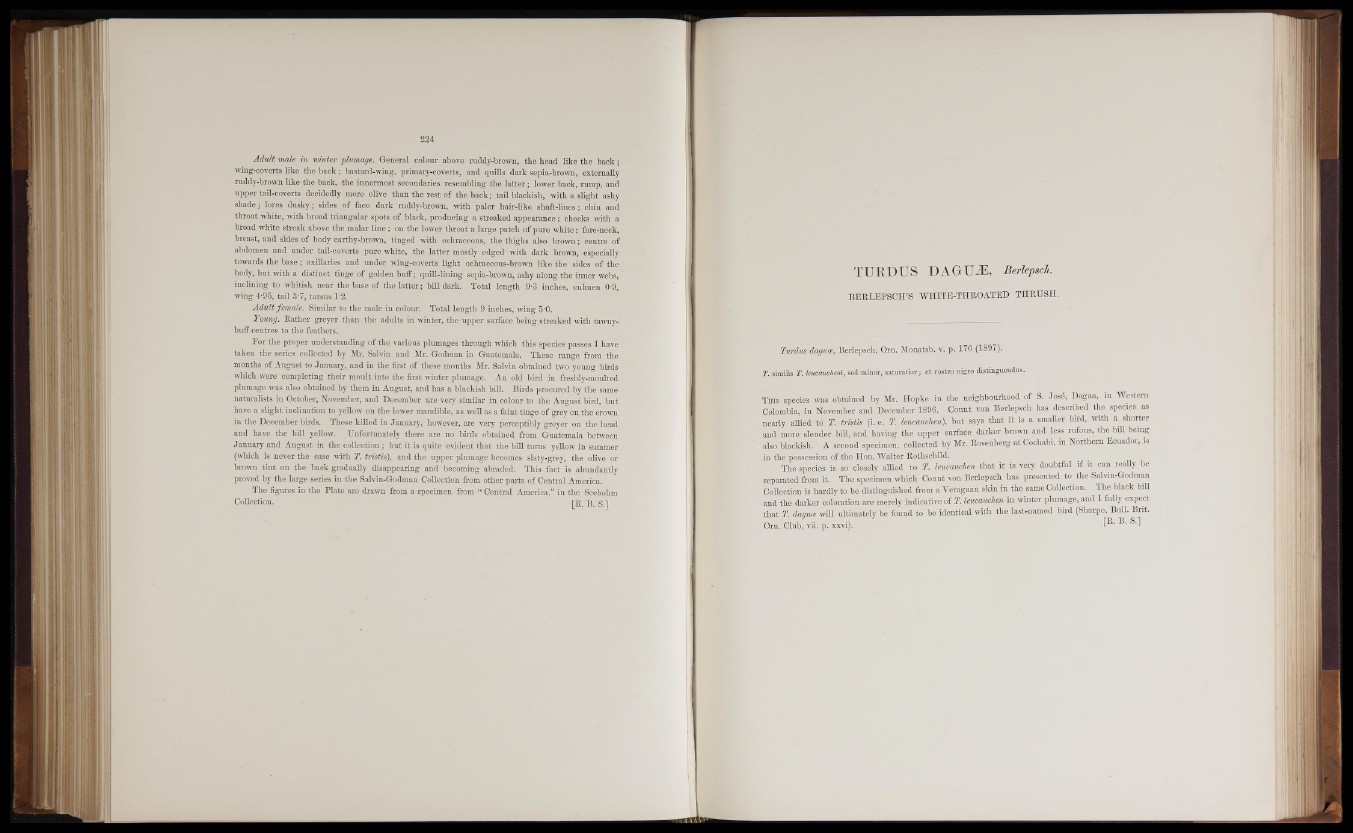
Adult male in winter plumage. General colour above ruddy-brown, the head like the back ;
wing-coverts like the back ; bastard-wing, primary-coverts, and quills dark sepia-brown, externally
ruddy-brown like the back, the innermost secondaries resembling the latter ; lower back, rump, and
upper tail-coverts decidedly more olive than the rest of the back; tail blackish, with a slight ashy
shade ; lores dusky ; sides of face dark ruddy-brown, with paler hair-like shaft-lines ; chin and
throat white, with broad triangular spots of black, producing a streaked appearance ; cheeks with a
broad white streak above the malar line ; on the lower throat a large patch of pure white ; fore-neck,
breast, and sides of body earthy-brown, tinged with ochraceous, the thighs also brown ; centre of
abdomen and under tail-coverts pure white, the latter mostly edged with dark brown, especially
towards the base ; axillaries and under wing-coverts light ochraceous-brown like the sides of the
body, but with a distinct tinge of golden buff ; quill-lining sepia-<brown? ashy along the inner webs,
inclining to whitish near the base of the latter; bill dark. Total length 9*3 inches, culmen 0*9,
wing 4*95, tail 3'7, tarsus 1-2.
Adult female. Similar to the male in colour. Total length 9 inches, wing 5-0.
young. Rather greyer than the adults in winter, the upper surface being streaked with tawny-
buff centres to the feathers.
Tor the proper understanding of the various plumages through which this species passes I have
taken the series collected by Mr. Salvin and Mr. Godman in Guatemala. These range from the
months of August to January, and in the first of these months Mr. Salvin obtained two young birds
which were completing their moult into the first winter plumage. ' An old bird in freshly-moulted
plumage was also obtained by them in August, and has a blackish bill. Birds procured by the same-
naturalists in October, November, and December are very similar in colour to the August bird, but
have a slight inclination to yellow on the lower mandible, as well as a faint tinge of grey on thè crown
in the December birds. Those killed in January, however, are very perceptibly greyer on the head
and have the bill yellow. Unfortunately there are no birds obtained from Guatemala between
January and August in the colléction ; but it is quite evident that the bill turns yellow in summer
(which is never the case with T. tristis), and the upper plumage becomes slaty-grey, the olive or
brown tint on the back gradually disappearing and becoming abraded. This fact is abundantly
proved by the large series in the Salvin-Godman Collection from other parts of Central America.
The figures in the Plate are drawn from a specimen from “ Central America,” in the Seebohm
Collection. rg |gj
TURDUS DAGrUÆ, Berlepsch.
BERLEPSCH’S WHITE-THROATED THRUSH.
Turdus daguoe, Berlepsch, Orn. Monatsb. v. p. 176 (189/).
T. similis T. leucaucheni, sed minor, saturatior;. et rostro nigro distinguendus.
T his species was obtained by Mr. Hopke in. the neighbourhood of S. José, Dagua, in Western
-Colombia, in November and December 1896. Count Ton Berlepsch has described ■ the species as
nearly allied to7 T. tristis _ (i. e. T. leucauchen), but says that it is a smaller bird, with a shorter
and more slender bill, and having the upper surface darker, brown and less rüfous, the bill being
also blackish. A second specimen, collected by Mr. Rosenberg at Cochabi, in Northern Ecuador, is
in the possession of the,Hon. Walter Rothschild.
The species, is-so closely allied to T. leucauchen that it is very doubtful if it can really be
separated from it. The specimen which Count v o n . Berlepsch has presented to the Salvin-Godman
Collection is hardly to be distinguished from a Veraguan skin in the same Collection. The black bill
and the darker coloration are merely indicative of T. leucauchen in winter plumage, and I fully expect
that T. daguoe will ultimately be found to be identical with the last-named bird (Sharpe, Bull. Brit.
Orn. Club, vii. p. xxvi).